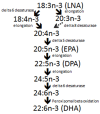Pork as a Source of Omega-3 (n-3) Fatty Acids
- PMID: 26694475
- PMCID: PMC4693156
- DOI: 10.3390/jcm4121956
Pork as a Source of Omega-3 (n-3) Fatty Acids
Abstract
Pork is the most widely eaten meat in the world, but typical feeding practices give it a high omega-6 (n-6) to omega-3 (n-3) fatty acid ratio and make it a poor source of n-3 fatty acids. Feeding pigs n-3 fatty acids can increase their contents in pork, and in countries where label claims are permitted, claims can be met with limited feeding of n-3 fatty acid enrich feedstuffs, provided contributions of both fat and muscle are included in pork servings. Pork enriched with n-3 fatty acids is, however, not widely available. Producing and marketing n-3 fatty acid enriched pork requires regulatory approval, development costs, quality control costs, may increase production costs, and enriched pork has to be tracked to retail and sold for a premium. Mandatory labelling of the n-6/n-3 ratio and the n-3 fatty acid content of pork may help drive production of n-3 fatty acid enriched pork, and open the door to population-based disease prevention polices (i.e., food tax to provide incentives to improve production practices). A shift from the status-quo, however, will require stronger signals along the value chain indicating production of n-3 fatty acid enriched pork is an industry priority.
Keywords: DHA; EPA; ETA; LNA; n-3; omega-3; pig; pork.
Figures



References
-
- Simopoulos A.P. Importance of the omega-6/omega-3 balance in health and disease: Evolutionary aspects of diet. World Rev. Nutr. Diet. 2011;102:10–21. - PubMed
-
- FAO Sources of Meat. [(accessed on 2 September 2015)]. Available online: http://www.fao.org/ag/againfo/themes/en/meat/backgr_sources.html.
-
- Teicholz N. The Big Fat Surprise: Why Butter, Meat and Cheese belong in a Healthy Diet. Simon and Schuster; New York, NY, USA: 2014.
Publication types
LinkOut - more resources
Full Text Sources
Other Literature Sources
Research Materials
Miscellaneous

